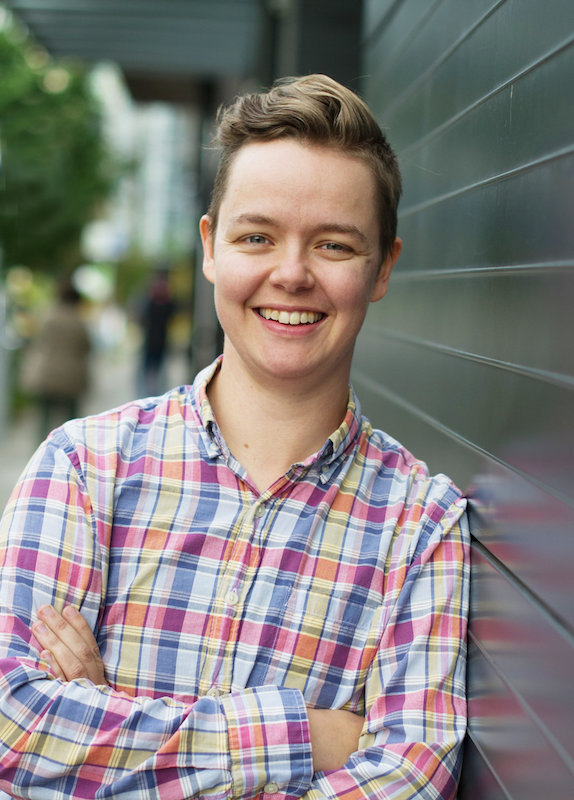
In the Spotlight: Meg Bolger, social justice workshop facilitator and educator
By Olivia Barrow
Eliminating biases connected to sexuality and gender is an effort that is foundational to Doyenne’s mission of empowering women entrepreneurs.
This month, I spoke with someone whose passion is helping individuals understand their biases related to gender and sexuality issues.
Meg Bolger has dedicated her career to social justice education work, specifically focusing on gender and sexuality. For nearly 10 years, she has been leading social justice workshops, teaching others to run workshops, and co-creating educational resources to help facilitators in similar fields.
She has worked with nonprofits, universities, and increasingly more for-profit tech companies, and she has a lot of insight to share about the barriers every organization faces in trying to move the needle around diversity issues.
And one of them starts with using the blanket term “diversity” without clearly defining it.
You’ve led gender and sexuality workshops and trainings all over the country. Does it feel different to lead one of these in a so-called progressive city versus a more conservative place?
I’ve found that people in conservative places have a better sense of their starting place than people in progressive cities like Seattle. When we (me and my collaborator Sam Killermann) started facilitating train-the-trainers where we were preparing people to lead LGBTQ 101 trainings, often times liberal universities would say things like, “We’ve had gay people here forever. Can we get the 201 training?” They’d think they were more advanced in their understanding, but then I’d get there and they would say things that would make me think, “You have not unpacked that yet, but you think you have, and that’s harder.” That creates a more challenging learning environment.
When we went to places like Florida or Arkansas, they would say things like, “We know we probably aren’t doing this well.”
When people think they are advanced, they don’t pay attention the way that people who know they don’t know something do. With people who know they’re just starting, there’s an openness to be wrong.
The people in conservative places have a better sense of their starting point.
What has changed about the environment for doing social justice training between now and 10 years ago?
Social justice has gone mainstream, which means the gap between people is bigger than ever. When I was in college, I would say there were the super social justice activist kids, and then there were the kids who that was not their thing. And the gap between those two groups was pretty large, but even for the social justice crowd, it wasn’t like every article on your Facebook was constantly putting out social justice info. You had to really ingrain yourself in those communities if you wanted that much exposure. But I know people now whose main thing isn’t social justice activism, but they still consume almost as much of that content as I do.
You’d think that the gap would get smaller as diversity and inclusion gets more mainstream. What’s happening?
I think the gap between people has gotten bigger because people spend so much time in it. So there are more people who think they know more. And they do know more, but we are not increasing our ability to talk to folks who disagree with us.
What do you think is one of the biggest challenges that organizations face in their diversity and inclusion efforts?
I think one of the problems that’s going on right now is that some of us want social justice outcomes—greater equality and equity between people. An acknowledgment of the inequitable baselines people are coming from. Acknowledgement that our system is not set up for people, it’s set up for profit; that capitalism is inherently exploitative; that wealth disparities shouldn’t be this extreme. An end to racism. For me, those are social justice outcomes.
But diversity is not that. “Diversity” and “inclusion” are different from social justice. You can have diversity without having social justice.
I’ve been in conversations with folks who are saying, “How do we get more women, how do we get more people of color into positions of leadership?” They aren’t asking how to disrupt the power dynamics that are creating barriers for these folks to access those positions in the first place. They aren’t questioning the systems that created a C-suite of all white men. Or the power dynamics that are going to exist when people of different identities do enter that space.
There is an assumption that you can keep things the same, but have people of different identities in these positions. To me this means you might be solving the “diversity” problem, but not ever addressing equity/inclusion or injustice that created the homogeneity or power imbalances to begin with.
What happens when organizations overuse diversity as a blanket term when they really mean social justice?
We get into unnecessary battles and struggles when we are not specific. If I say, “I don’t think your company is very diverse,” someone can counter and say, “We have Muslims, Christians, we have people from Ohio, Florida—that’s pretty diverse to me.”
If the conversation I want to have is that this organization serves many people of color but their staff is 90% white, then I need to back up and say, “I mean racial diversity, specifically black and brown employees.” Then if that person replies, “I don’t see why racial diversity is a big deal,” then we can actually have a real conversation and identify where we have a disagreement, instead of getting stuck arguing about whether or not there is “diversity” in the organization.
When you’re not specific, people feel like things aren’t actionable. If you just say, “We need a more equitable business ecosystem,” people don’t know where to start. But if you make a specific list of 10 things that would make the ecosystem more inclusive, then they can actually start to take action.
Why is it scary to be specific when talking about diversity and inclusion? Why do we revert to using such vague language?
Sometimes it’s this idea that I’m a good liberal person, so I’m going to parrot these words I heard from someone I respect, even if I don’t know what they mean. People say vague things to sound smart, to be part of the in-group.
Other times I think it might be a fear of rejection if you say something specific. What if I tell people how I actually feel, and then they say it’s not a big deal?
I think people sometimes use vague words when they’re afraid of (or know) the consequences of actually being specific. It might be OK to say, “This company is not very inclusive,” but it might get you fired to specifically speak out about how it fails to include specific types of people.
Another way you sometimes work with organizations is to help them uncover unintended consequences in their processes. Can you share any examples of that?
I was working with a camp that is free to attend, and we were talking about wanting to increase the racial and socio-economic diversity of the kids they serve. Up to this point they were doing first-come first-serve registration. They felt that it was the most unbiased, because they weren’t specifically choosing kids—they were just using this standard system.
But first-come-first-served is biased. It’s biased in favor of the people who are ready to go with the application on day one, who have a computer at home, who came last year. It’s biased towards people who speak English (the language the forms were written in), who had all their documents in order, who had time to fill out the forms as soon as they went live. The organization thought their process was super neutral because everyone has the same opportunity to come first. But if you dig into it, the people who are able to come first are the people with more resources. If you want to create equal opportunities to access, you have to dig into all the ways that people are already playing with more resources at their disposal.
So often we don’t realize how systems like first-come first-serve or word-of-mouth advertising are biased. Perhaps they are biased in ways we’re comfortable with, and if so, that’s great. But perhaps they are creating unintended consequences, and if that’s the case, then we need to optimize for what we want and reimagine the systems.

